
A good day, I would say. We didn’t really retrace anything, but at least we didn’t fall. This is the second day in a row where we are still not out of the woods. Given the kind of bloodletting that had happened in the last year or eight or nine days, any day which is flat or slightly up seems good. But we certainly cannot say today that we are out of the woods. That’s something we can’t claim yet. Hopefully, these two days will help build some sort of a base, and that’s the best hope we can have right now.
In the second half of the blog, we will discuss the perfect recipe for a disaster in your portfolios and the biggest mistakes some people make in their investing.
Where is the market headed?
Market Overview
Now, let’s see where the market is headed. What have we done in the last couple of sessions? We’ve been on an inside bar, meaning these two candles are inside the long bar we saw with the Monday fall. We are yet to really recover from the breakdown level around 23,300. If we go above 23,300, not only would we cross today’s high, but we will also surpass the breakdown point, which would bring some confidence back into the market. If we don’t go there and instead start to fall over the next couple of days—perhaps even to 23,000—then there’s really no near support for the market. The market is certainly in a downtrend, and that trend has not ended yet. We can hope that it may end, but we cannot be sure about it at this point.
Nifty closed up 0.16%, but it made an attempt to go above yesterday’s high, failed, and stopped there.
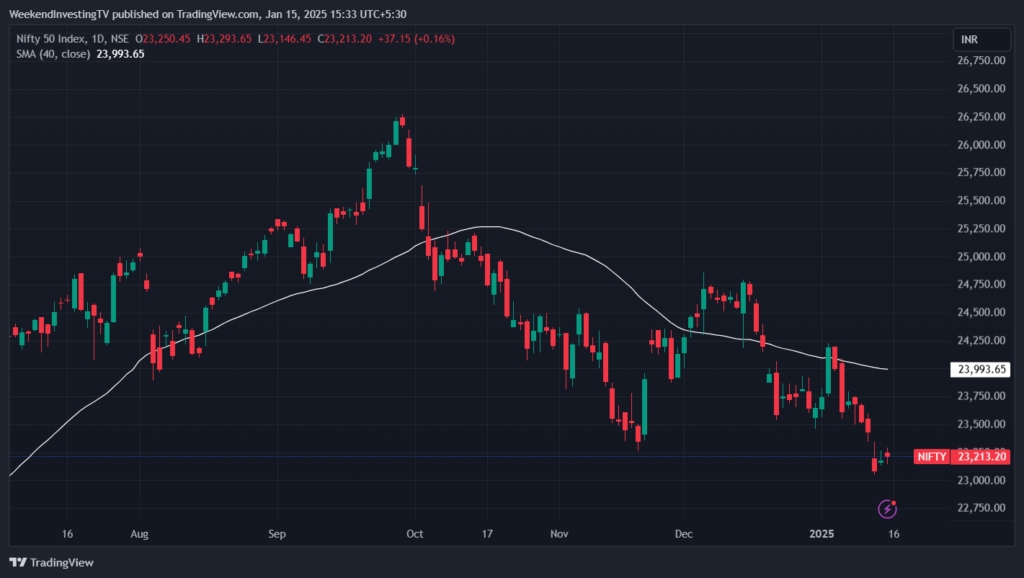
Nifty Next 50
Nifty Junior was slightly better than Nifty, closing at 0.88%, above the two-day high, and almost closing the gap. But Nifty Junior has also fallen the most from 78,000 to nearly 61,000, a drop of over 20%. It is also a bit away from the moving average. We are using the 40-day moving average, and whenever the current price moves far away from the 50-day or 40-day moving average, it tends to bounce back or at least recover to some extent. This has moved quite far from the average, so we may see a few flattish days before it catches up and then perhaps falls again. Right now, this is probably looking better than Nifty.
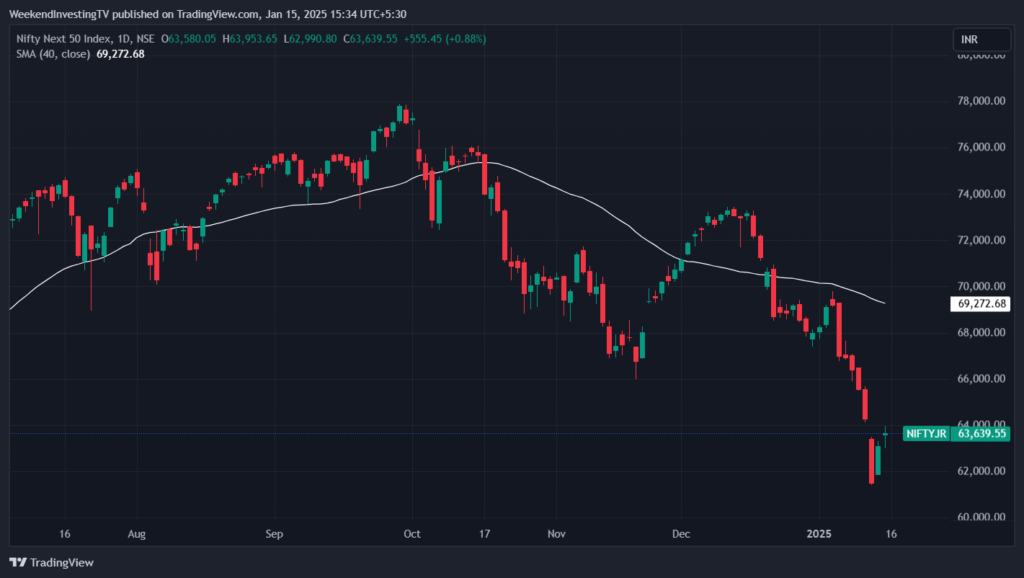
Nifty Mid and Small Cap
The mid-cap index has recovered all of its fall from Monday’s open, but it still hasn’t closed the gap, ending up 0.36%. I wouldn’t complain about this; it’s still a decent formation on the chart.
On the small-cap side, it’s also an inside bar with two inside bar days and yet to recover from the breakdown point. Small-caps closed up by half a percent for the day, which isn’t too bad. It always takes time for the market to find its feet again, and that process seems to be underway.
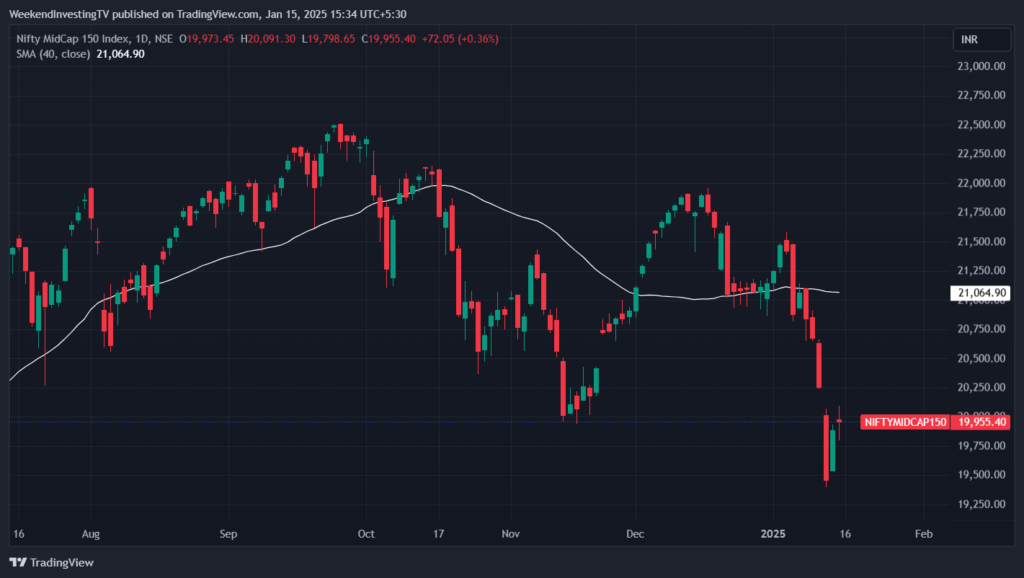
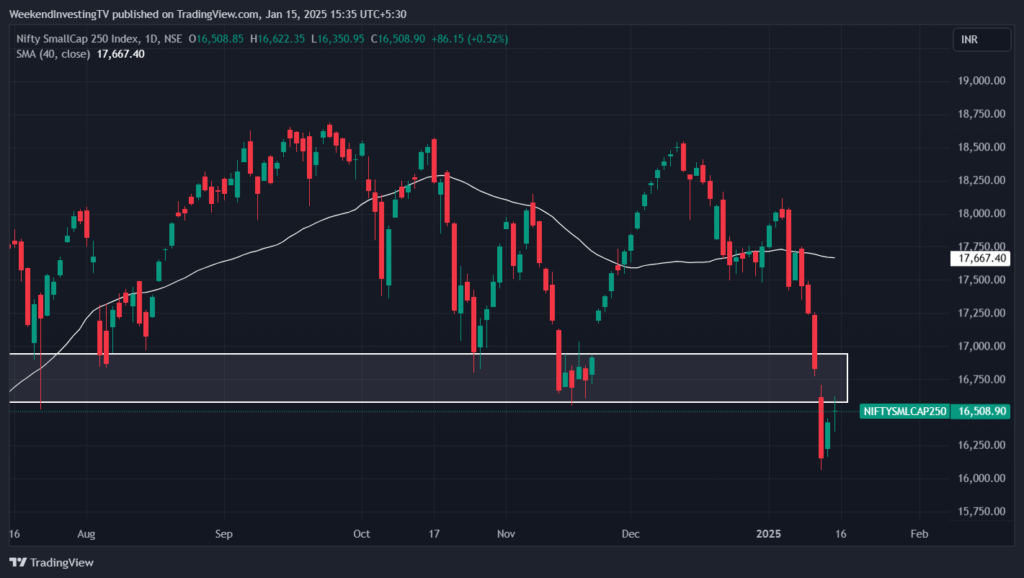
Nifty Bank Overview
The Bank Nifty was completely flat, up by just 0.05%. It made an attempt to go up but couldn’t sustain there, closing at a flat position.
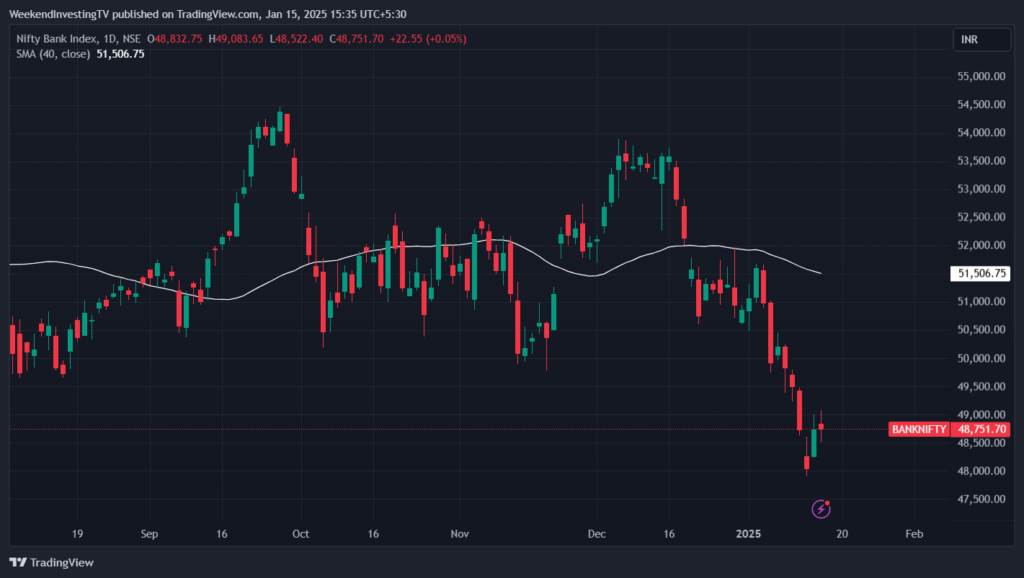
Advanced Declined Ratio Trends
Advanced-declines were very equal today, with 238 declines to 257 advances in the top 500 stocks.

Nifty Heatmap
In the Nifty heatmap, the biggest losers were Mahindra & Mahindra, the Bajaj twins, SBI Life, Axis Bank, and Sriram Finance. On the other hand, Kotak Bank recovered very nicely, up 2%, and Reliance rose 1%. Power stocks such as NTPC and Power Grid zoomed up by 3.5% and 2.9%, respectively. Maruti and Aishwarya did well, as did Tech Mahindra, which gained 1.7%. Coal India was up 1.5%, and Trent gained 3.7%. Many stocks showed signs of recovery today.
Looking at Nifty Next 50, as you can see, there’s much more green. Zomato, on the verge of index inclusion, jumped 4.4%, while Demat (D-Mart) rose 2.6%. Other notable gainers included BHEL, Mother Son, ICICI GI, and Adani stocks, with energy stocks like Tata Power doing well. Power and energy stocks were clearly strong performers today, as were some cement stocks like PFC.
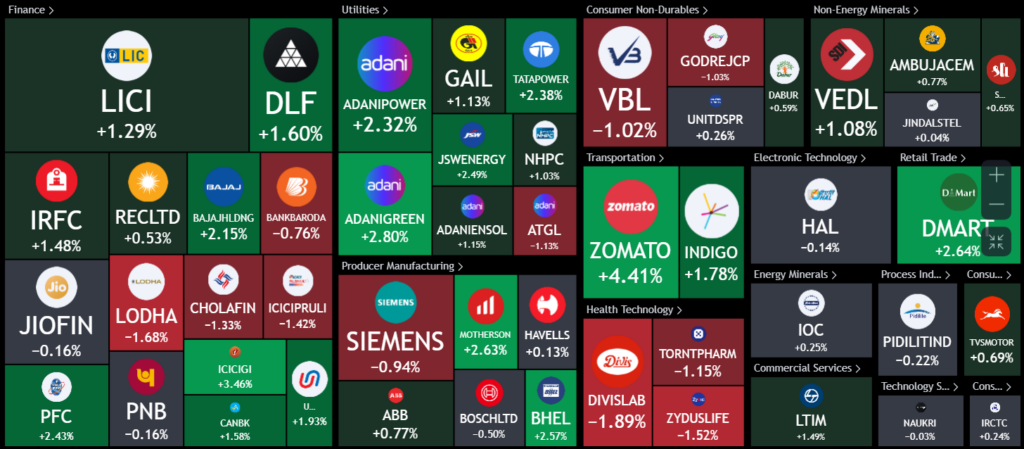
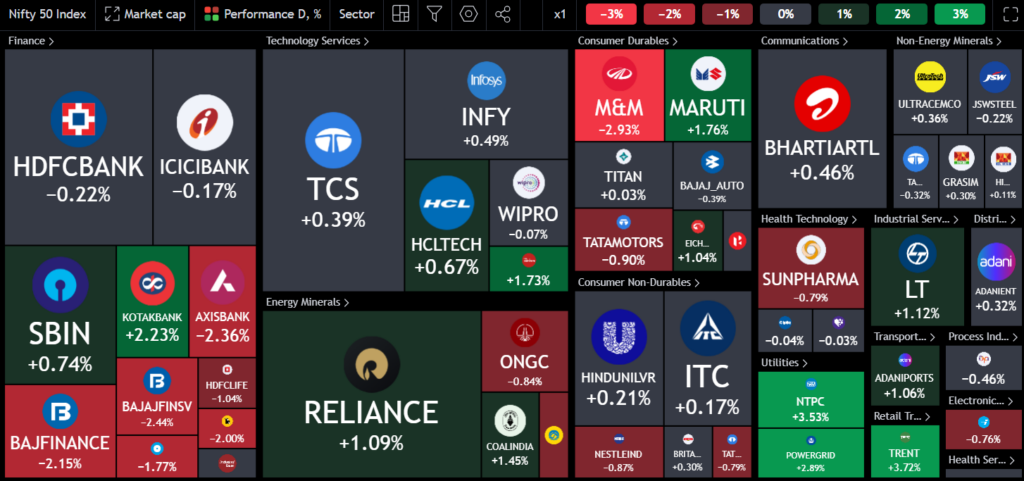
Sectoral Overview
The sectoral trends for today showed real estate trying to make a comeback, up 1.4% for the day. After today’s gain, it had still fallen 9.6% this week. Pharma, auto, and FMCG sectors took a backseat, with declines of 1%, 0.5%, and 0.1%, respectively. FMCG is at a cusp of a breakdown, so it may either go further down or may already be too oversold. Over the last 12 months, pharma, private banks, and energy are the only sectors that have not made any money. Even PSU banks are down 3.9% over the last 12 months. Sectors like Infra, public sector enterprises, IT, and real estate did well today, with stocks such as Phoenix Mills, Raymonds, Mahindra Lifespace, Brigade, and DLF among the top performers. However, the charts for these sectors are not particularly bullish; they seem more stable or perhaps just waiting for the next move down. Real estate stocks are at some support levels in the index.
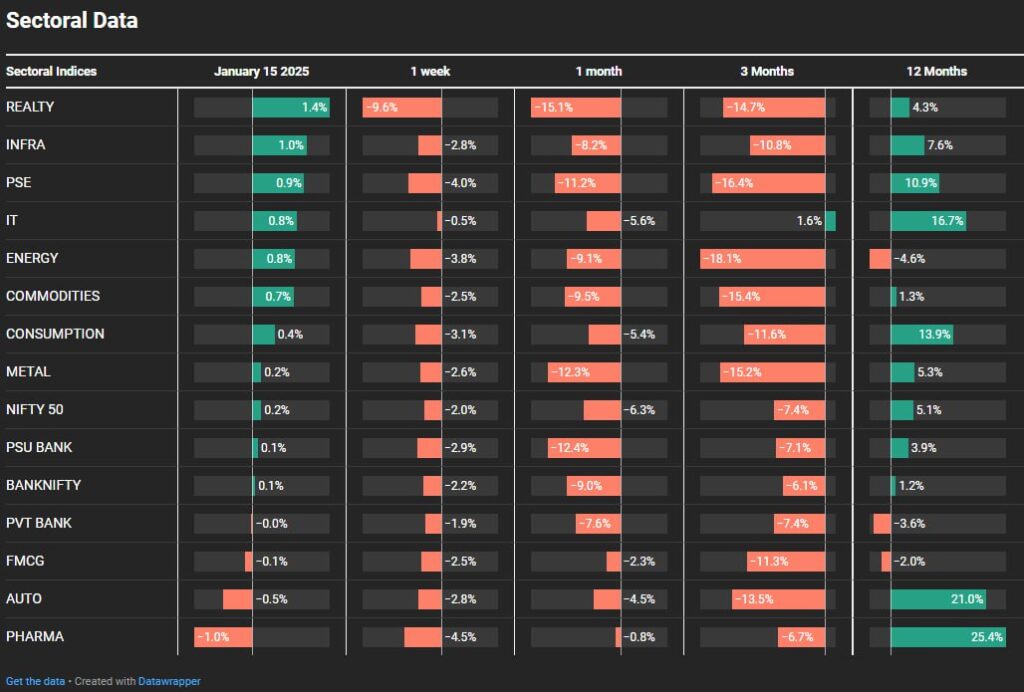
Sectors of the Day
Nifty REALTY Index

Story of the Day : The perfect recipe for disaster in the markets.
We’re talking about PSU banks today. Since June 2024, Nifty has been flat. We went up, we came down, but public sector banks have been on a consistent decline, down 23%, nearly 27%. Notably, there are no PSU bank stocks above the 200 DMA anymore. This was 25% in December, and now it’s down to 0%. In fact, all PSU bank stocks were above the 50 DMA until December 17th, but have since collapsed to zero. This tells us that the sector has virtually collapsed for now. In the last month, all these PSU banks have lost significant value.
Looking at longer-term returns, however, things were better. State Bank of India (SBI) was up 23.7% over the past year, and Indian Bank was up 22.6% over six months. But in the last six months, they’ve collapsed, showing returns of just 10-15%. Over three years, their returns were still good, but relying on past performance isn’t the best strategy. The trend that existed a few months ago is no longer there, and it’s clear that something is going wrong in the sector.
If we look at the period from July 2022 to June 2024, PSU banks outperformed Nifty significantly, especially after the first few months of 2024. During this time, there were major announcements related to PSU banks, including the launch of ETFs and funds targeting this sector. However, what happened before July 2022 tells a different story. In the previous 12 years (2011-2023), the PSU bank index did absolutely nothing—it was flat. In contrast, private banks went up by 340%, and Nifty went up by 111%. No one was touching PSU banks back then, but suddenly, things changed, and PSU banks took off, gaining attention through ETFs and focused funds, before collapsing.
The problem lies in the lack of understanding about sectoral cyclicality. When you invest in a sector, you need to consider your entry and exit strategy. Are you thinking about it from a sectoral point of view or from an individual stock perspective? Either way, you must have a framework for both entering and exiting the sector. You can’t just put your money in and wait to see what happens.
This is a key mistake in investing. Many retail investors fall into this trap because they don’t account for sector cycles. They invest in a hot sector without considering how to get out of it when the trend changes. Over the last 18 years, we see periods where PSU banks outperform the wider market, but there are also years with huge underperformance. It’s essential to understand that sectors go through periods of low interest followed by short, sharp bursts of interest.
As of the end of 2024, 41% of all funds in the market are sectoral or thematic in nature. Whenever a theme becomes popular, a fund or ETF is launched, capitalizing on the FOMO of the moment. These funds are often sold by showcasing recent performance (3 months, 6 months, 1 year), but they rarely show 5-year performance. The problem is that the incentives of those selling these funds are not aligned with those buying them. The producers and distributors make money, but the retail investors may not necessarily benefit, especially in the long run.
So, don’t fall into this trap. This is a classic pitfall for retail investors. Avoid being swayed by recency bias, greed, and the lack of awareness about how to exit a sector or stock. A key issue in the market is that many people invest in just one or two sectors without diversifying.
What has been your experience with sectoral-based themes? How do you handle your portfolio investments? If you’re investing in funds or momentum-based strategies, sectors naturally keep getting rejected or accepted, so at least that part of your framework is sorted out.
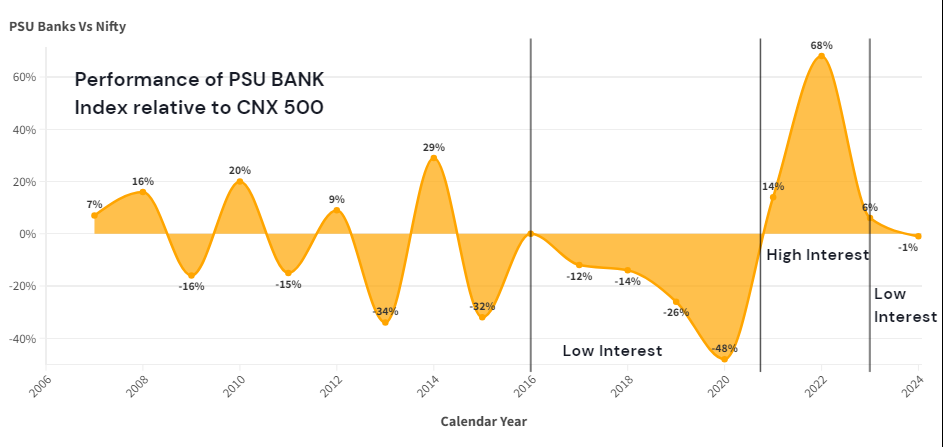
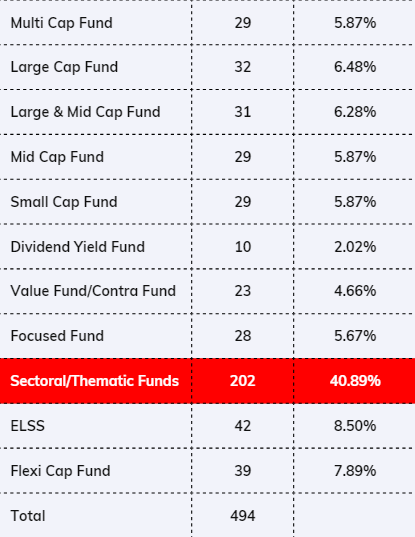
WeekendInvesting launches – PortfolioMomentum Report
Disclaimers and disclosures : https://tinyurl.com/2763eyaz






